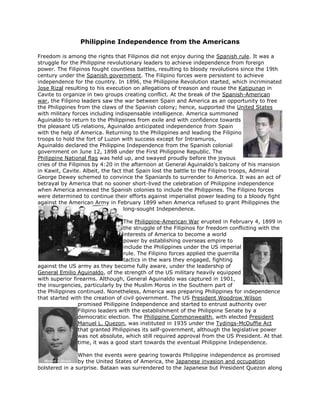
Philippine independence from the americans
- 1. Philippine Independence from the Americans<br /> <br />Freedom is among the rights that Filipinos did not enjoy during the HYPERLINK quot; http://www.philippine-history.org/spanish-colonial-masters.htmquot; Spanish rule. It was a struggle for the Philippine revolutionary leaders to achieve independence from foreign power. The Filipinos fought countless battles, resulting to bloody revolutions since the 19th century under the HYPERLINK quot; http://en.wikipedia.org/wiki/Spanish_Governmentquot; Spanish government. The Filipino forces were persistent to achieve independence for the country. In 1896, the Philippine Revolution started, which incriminated HYPERLINK quot; http://en.wikipedia.org/wiki/Jos%C3%A9_Rizalquot; Jose Rizal resulting to his execution on allegations of treason and rouse the HYPERLINK quot; http://www.philippine-history.org/katipunan.htmquot; Katipunan in Cavite to organize in two groups creating conflict. At the break of the HYPERLINK quot; http://www.philippine-history.org/spanish-american-war.htmquot; Spanish-American war, the Filipino leaders saw the war between Spain and America as an opportunity to free the Philippines from the claws of the Spanish colony; hence, supported the HYPERLINK quot; http://www.usa.govquot; United States with military forces including indispensable intelligence. right0America summoned Aguinaldo to return to the Philippines from exile and with confidence towards the pleasant US relations, Aguinaldo anticipated independence from Spain with the help of America. Returning to the Philippines and leading the Filipino troops to hold the fort of Luzon with success except for Intramuros, Aguinaldo declared the Philippine Independence from the Spanish colonial government on June 12, 1898 under the First Philippine Republic. The HYPERLINK quot; http://www.philippine-history.org/philippine_flag.htmquot; Philippine National flag was held up, and swayed proudly before the joyous cries of the Filipinos by 4:20 in the afternoon at General Aguinaldo’s balcony of his mansion in Kawit, Cavite. Albeit, the fact that Spain lost the battle to the Filipino troops, Admiral George Dewey schemed to convince the Spaniards to surrender to America. It was an act of betrayal by America that no sooner short-lived the celebration of Philippine independence when America annexed the Spanish colonies to include the Philippines. The Filipino forces were determined to continue their efforts against imperialist power leading to a bloody fight against the American Army in February 1899 when America refused to grant Philippines the long-sought Independence.left0The HYPERLINK quot; http://www.philippine-history.org/filipino-american-hostilities.htmquot; Philippine-American War erupted in February 4, 1899 in the struggle of the Filipinos for freedom conflicting with the interests of America to become a world power by establishing overseas empire to include the Philippines under the US imperial rule. The Filipino forces applied the guerrilla tactics in the wars they engaged, fighting against the US army as they become fully aware, under the leadership of HYPERLINK quot; http://en.wikipedia.org/wiki/Emilio_Aguinaldoquot; General Emilio Aguinaldo, of the strength of the US military heavily equipped with superior firearms. right0Although, General Aguinaldo was captured in 1901, the insurgencies, particularly by the Muslim Moros in the Southern part of the Philippines continued. Nonetheless, America was preparing Philippines for independence that started with the creation of civil government. The US HYPERLINK quot; http://www.whitehouse.gov/about/presidents/woodrowwilson/quot; President Woodrow Wilson promised Philippine Independence and started to entrust authority over Filipino leaders with the establishment of the Philippine Senate by a democratic election. The HYPERLINK quot; http://www.philippine-history.org/philippine-commonwealth.htmquot; Philippine Commonwealth, with elected HYPERLINK quot; http://en.wikipedia.org/wiki/Manuel_L._Quezonquot; President Manuel L. Quezon, was instituted in 1935 under the HYPERLINK quot; http://www.philippine-history.org/tydings-mcduffie-law.htmquot; Tydings-McDuffie Act that granted Philippines its self-government, although the legislative power was not absolute, which still required approval from the US President. At that time, it was a good start towards the eventual Philippine Independence.left0When the events were gearing towards Philippine independence as promised by the United States of America, the HYPERLINK quot; http://www.philippine-history.org/japanese-occupation.htmquot; Japanese invasion and occupation bolstered in a surprise. Bataan was surrendered to the Japanese but President Quezon along with Osmeña fled to America. HYPERLINK quot; http://www.bbc.co.uk/history/worldwars/wwtwo/quot; World War II broke out that created immense damage to Filipinos with roughly about one million casualties. After the war, HYPERLINK quot; http://www.op.gov.ph/museum/pres_roxas.aspquot; Manuel Roxas was elected President in April 1946 for the independent Second Republic of the Philippines. In a formal declaration, the American flag was lowered in Luneta, Manila and raised the Filipino National flag in tri-color of red, white, and blue looked up by proud Filipinos. Finally, independence was granted to the Republic of the Philippines dated July 4, 1946. The National anthem of the Philippines was played next to America’s. It was indeed a moment of liberating glory, for all Filipinos after pools of blood were shed in many revolutions.right0July 4, however, holds less inspiration for the Filipinos according to the elected President of the Republic of the Philippines in 1961, HYPERLINK quot; http://www.macapagal.com/dm2/quot; Diosdado Macapagal. Macapagal believes that the June 12, 1896 declaration of the HYPERLINK quot; http://www.philippine-history.org/malolos-congress.htmquot; Philippine independence by General Emilio Aguinaldo brings to memory the heroes of the revolution and therefore, Philippine independence is best commemorated in honor of the Filipino revolutionary heroes. Hence, President Macapagal changed the date of celebration of the Philippine independence from July 4 to June 12, which the Filipinos celebrate each year up to this time.<br />
